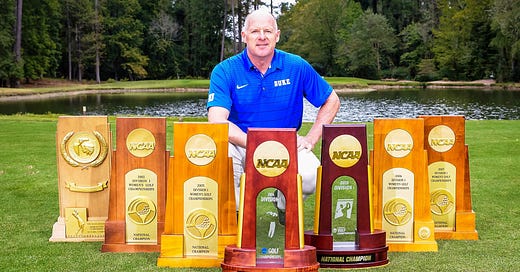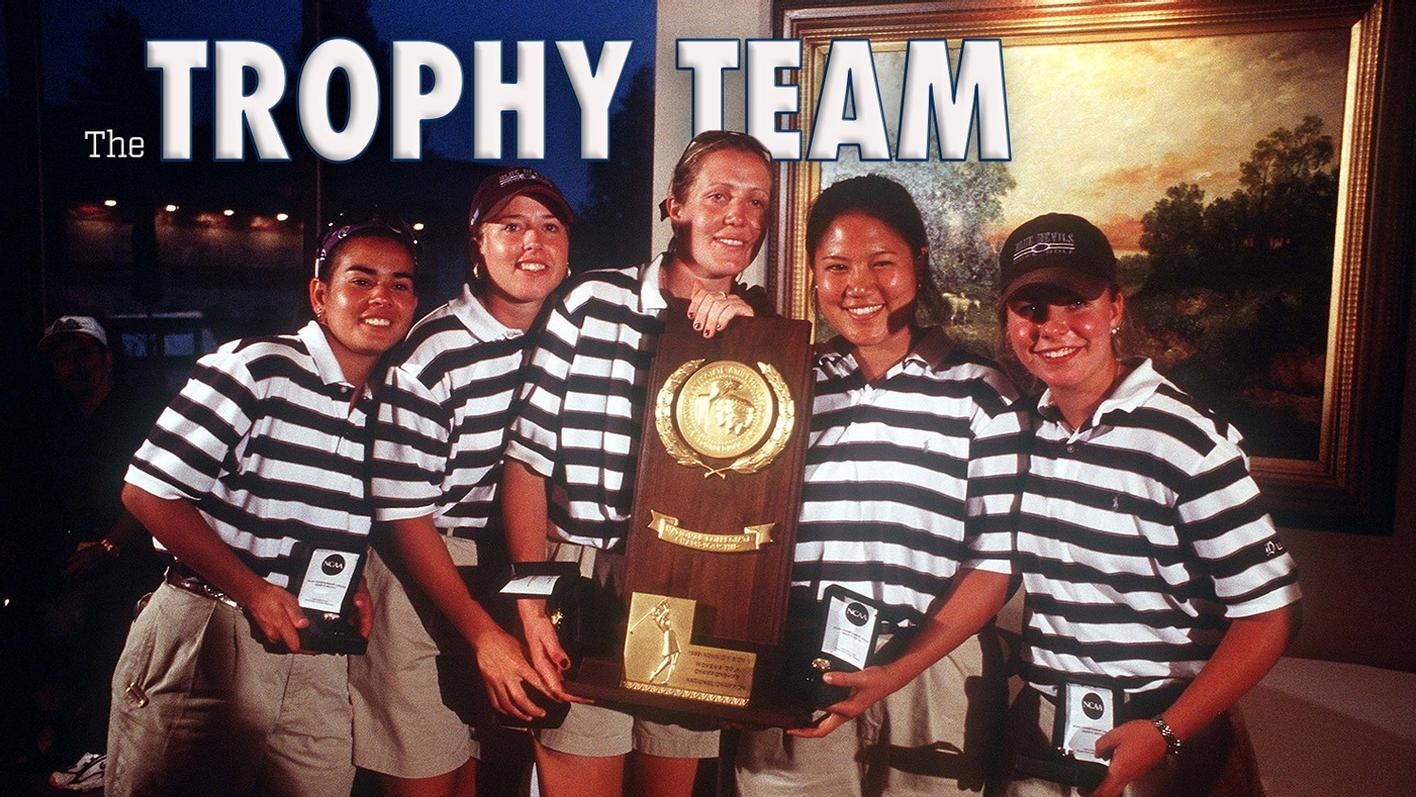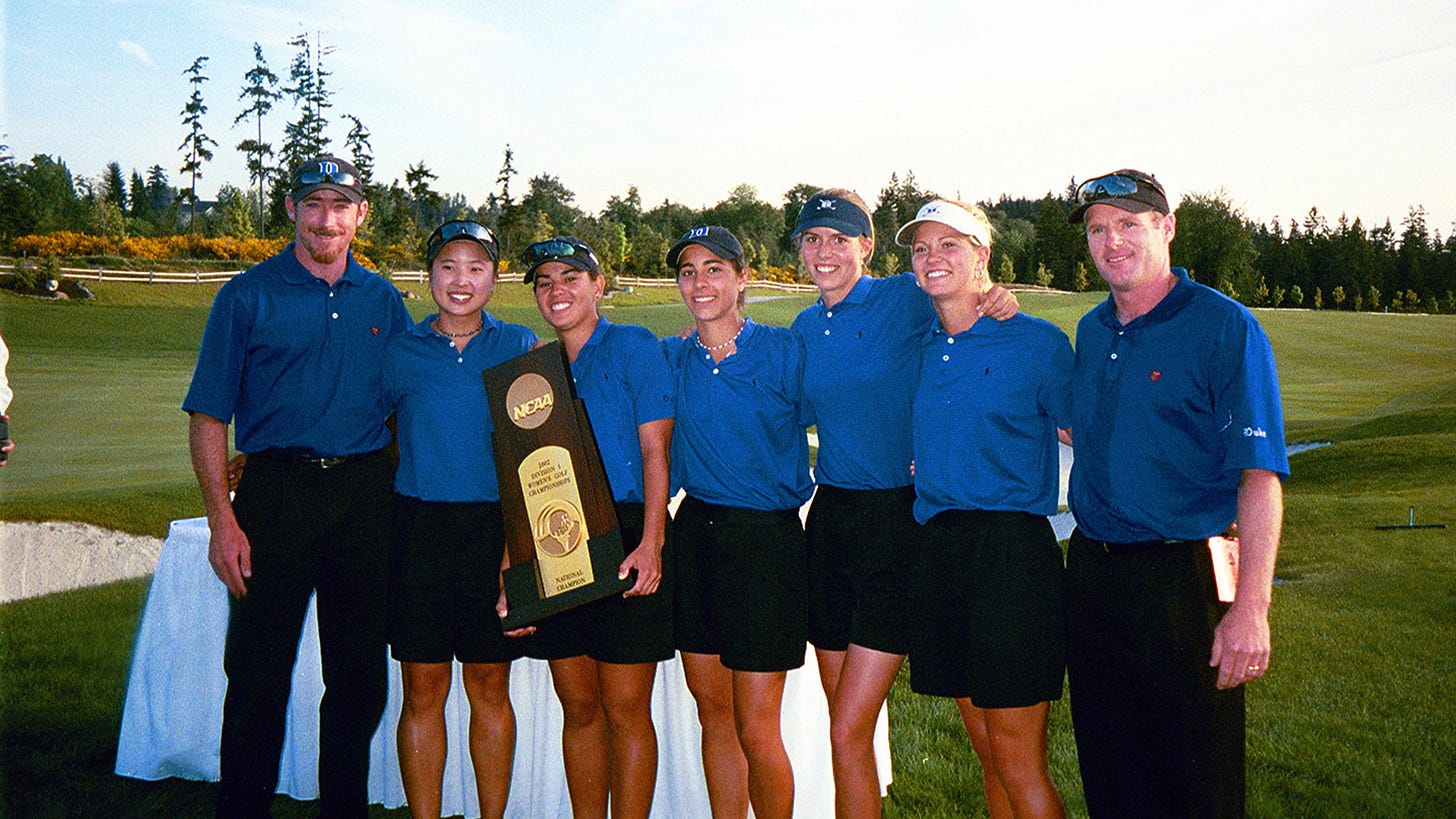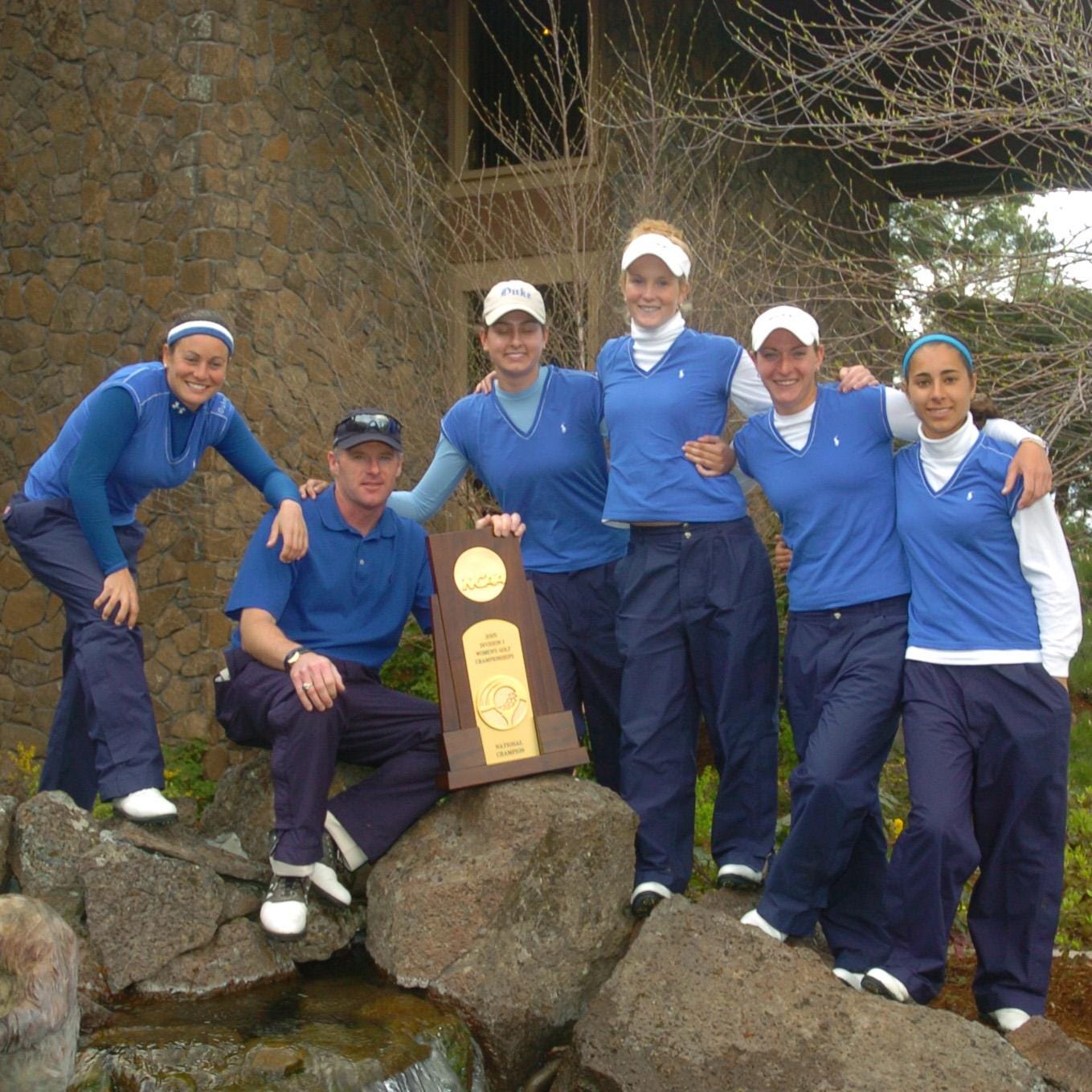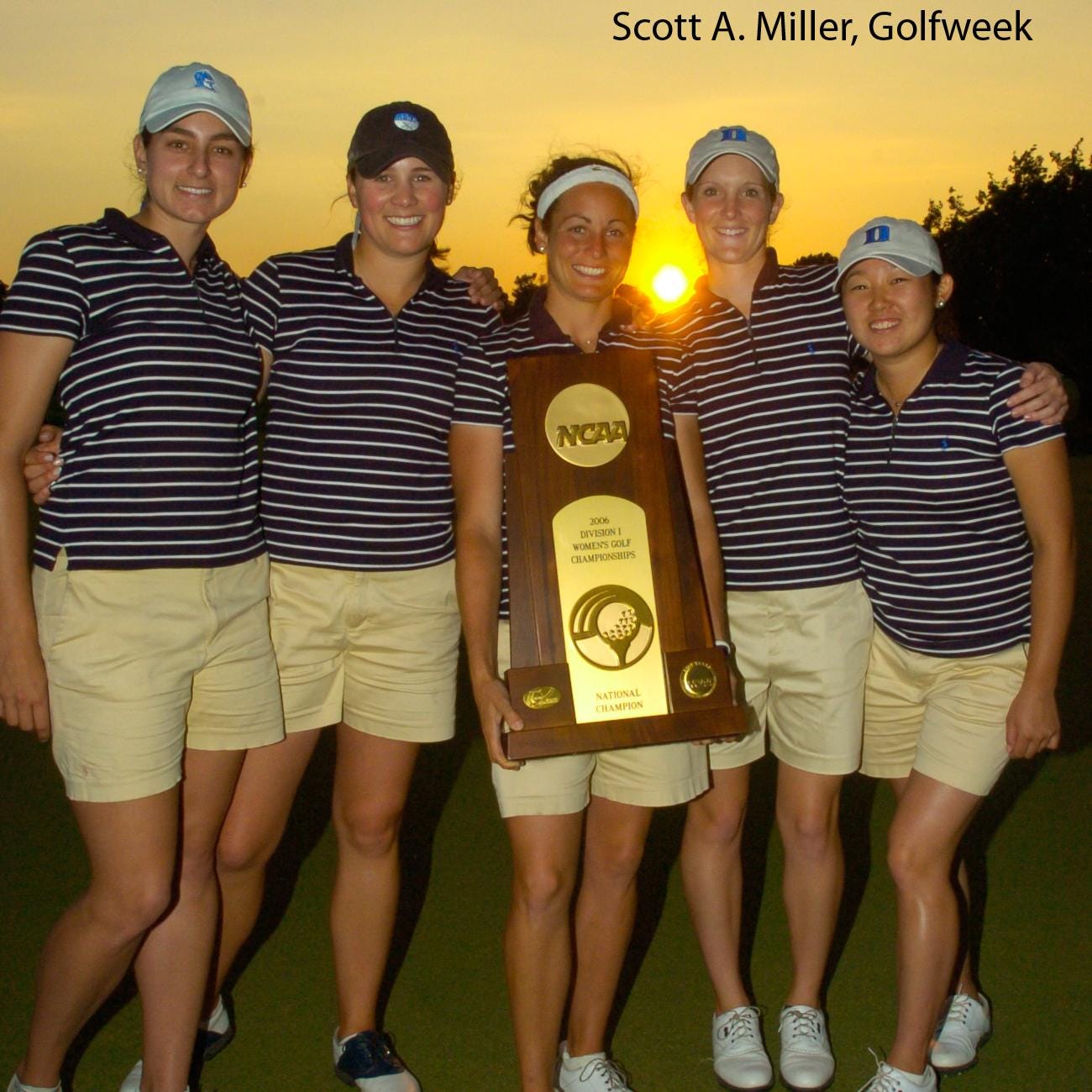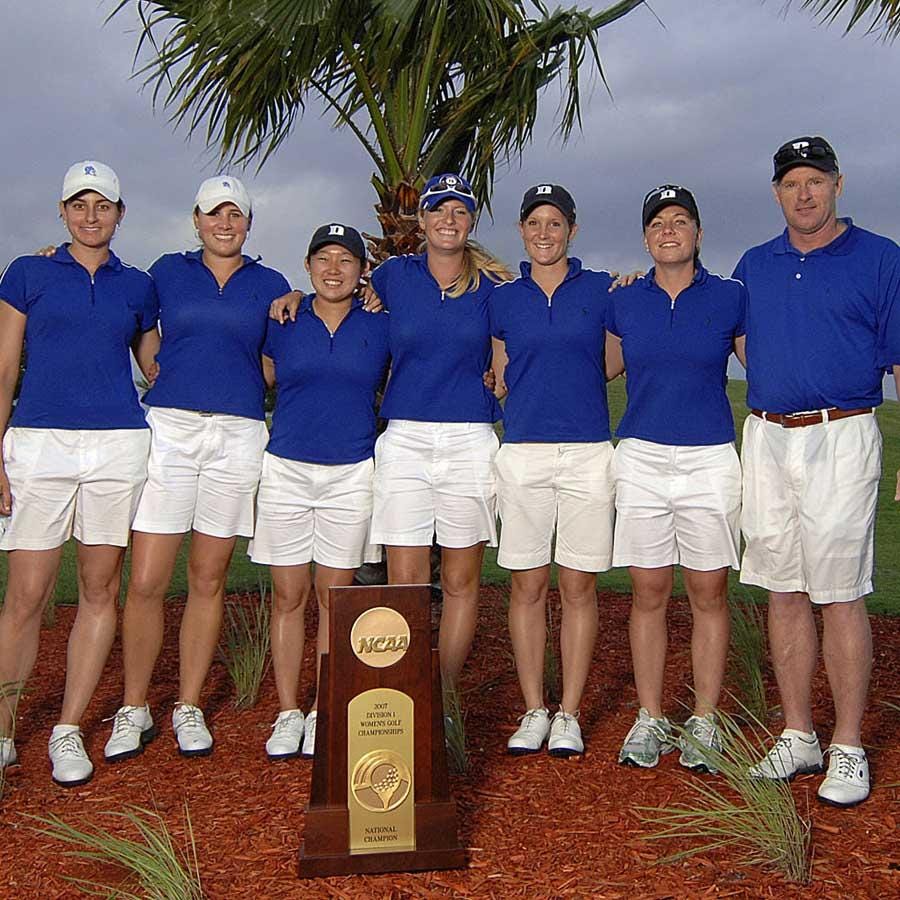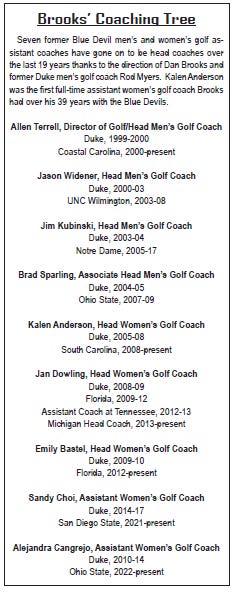This is part of a series on the Women’s Collegiate Championships
The transition into the new century (and millennia) brought with it a change in devils, from fiery orange Sun Devil to the icy Blue Devil. Now celebrating its 50th season, the Duke University women’s golf program has a long history of success, no period more so than the early 2000s. What seemed to some like a “fluke” victory in 1999 was quickly proven to be the start of an era of dominance as they earned a total of 5 NCAA national team titles in a 9 year span. Coach Dan Brooks added a 6th championship trophy in 2014, the last year that stroke play was used to crown the team champion, as well as a 7th in 2019. The photo below shows the interesting array of trophy styles the NCAA has used since it began governing the tournament in 1982, Duke having the distinct honor of being one of the few programs in the country to have one of each kind.
*NOTE: underlined text provides a link to references or sites with more information
THE 1999 CHAMPIONSHIP (REVISITED)
In the previous post we touched on the 1999 championship which had been halted with many of the top teams just 5 or so holes away from completing the fourth round. After several hours it became clear that the round wouldn’t be able to continue. Since the NCAA Championship Committee had in recent years ruled that the tournament could not be extended into Sunday, the Official on site made the impossibly tough call that the championship was finished, making the scores through Round 3 the final results.
FROM ANOTHER PERSPECTIVE
The Duke Blue Devils returned a number of strong players from the 1997-98 season, and added two of the top juniors in the country - Beth Bauer and Candy Hannemann - to make a run at the 1999 championship. Excitement for the season began even before the Fall as rising senior (3x All-American and 2x ACC Champ) Jenny Chuasiripom forced an incredible playoff in the US Open before eventually falling to Se Ri Pak. That excitement continued to grow as Duke won its first four tournaments to start the season, including the NCAA Fall Preview held at Tulsa Country Club, site of the upcoming NCAA championship. As Fall gave way to Spring, they continued to rack up victories, the seventh coming at the ACC Championship which also happened to be their fourth consecutive conference title. Beth Bauer captured the individual ACC title, making that three individual championships in that same timeframe. Soon after, Bauer tied for medalist honors in the (East) Regional, sending them back to the NCAA championship for the 10th time under the guidance of Coach Brooks.
Duke raced out to an early 12 stroke lead after the first round, but that lead was quickly halved with a less stellar second round. They were back into form for the third round, and at the end of the day (Friday), the team held an 8 stroke lead and Hannemann sat only 1 stroke back in the individual race. The next day, Saturday, Duke was playing steady and still held a 2 stroke advantage as the weather turned foul enough that officials had to blow the horn to stop play. Two hours later the call was made and Duke secured its first team championship, also the first women’s championship in school history. Their eighth tournament victory of the season broke their previous record of seven. The hasty end of the 1999 NCAA championship wasn’t particularly satisfying for anyone, but the #1 ranked team in the country finished on top.
VALIDATION [2001-2002]
As the calendar turned over from one decade/century/millennia to another, nobody quite knew what to expect from the Blue Devils. Though few voiced an opinion outright that the 1999 title might have been a “fluke”, that sentiment was quickly squashed nonetheless. With a runner-up finish (and individual title) in 2001 and the team (and individual) title in 2002, Coach Brooks proved to any doubters that Duke was not only a championship caliber program, but had also entered a new era of (Devil) dominance.
THE 2001 CHAMPIONSHIP
Coming off a year where they had won a fifth consecutive ACC title (freshman Maria Garcia-Estrada won medalist) and the East Regional title but finished a disappointing 14th at NCAAs, the Blue Devils were geared up for another run. Candy Hannemann, now a junior, led a team that returned all 5 starters from 2000 and included two of the top recruits in the country. One of those two was Bangkok, Thailand native Virada Nirapathpongporn, who immediately made her impact, becoming the third straight Duke freshman to win an ACC individual title. She then added the East Regional title just for good measure. As a team, the Blue Devils set many scoring records over the course of the season, extended their ACC winning streak to six, and set a new program record of 9 team victories when they successfully defended their East Regional title.
As the top ranked team in the country, Duke expected to be competitive at the 2001 NCAA championship. Through three rounds, they were exactly where they wanted to be, holding a four stroke lead over Georgia and Hannemann just four strokes behind the individual leader. The first three holes to start the final round on Friday were a disaster for Duke, shooting 7-over-par. That ballooned to 11-over-par by the time they made the turn which proved too deep of a hole to dig out of, but they managed to hold on for a runner-up finish. Hannemann posted another 69 to jump to the top of the leaderboard to finish tied with Lorena Ochoa [Arizona], the #1 rated player in the country. They trudged back out to the course for a playoff over four hours after finishing their final rounds. With a 6-foot par putt on the first playoff hole, Hannemann finally got her redemption and was crowned the first Duke individual NCAA golf champion. She and Nirapathpongporn were awarded 1st-Team All-American honors and Coach Brooks was named the Coach of the Year for the second time in three years.
“We got a real strong case of winning last year winning nine tournaments,” said [Coach] Brooks. “I think not winning at nationals, but playing well, was a tearful yet inspiring experience. It will propel us to work even harder next year.” - Duke Athletics, July 11, 2001
THE 2002 CHAMPIONSHIP
Matching the success from 2001 was a tall order for the 01-02 team, and that was made tougher when reigning NCAA champion Candy Hannemann sustained an injury that kept her out of the lineup for the entire Fall season. The Blue Devils were a strong team, but clearly missed their leader. With her back in the lineup to begin the Spring, Duke immediately returned to their winning ways. Their fifth consecutive tournament victory of the season came with their seventh straight ACC championship title; Hannemann taking the individual title by one stroke over teammate and reigning medalist Nirapathpongporn. They made it six in a row with their third consecutive East Regional title, this time it was sophomore Leigh Anne Hardin taking home medalist honors. By the end of the Spring, all five starters had earned medalist honors in at least one tournament.
Duke came to the 2002 NCAA championship ranked #2 in the country, and were third on the leaderboard after three rounds, just 3 strokes behind Arizona. The Wildcats were led by reigning Player of the Year Lorena Ochoa, who had accumulated an incredible 8 individual wins during the season and was on her way to repeating that honor. This time it was Arizona who relinquished the lead in the final round to finish runner-up. Undoubtedly with last year’s performance on their minds, the Blue Devils not only played a steady final round, they actually made a huge final push, accumulating 5 birdies in the final 3 holes to take the national title. Leading the charge was sophomore Virada Nirapathpongporn who earned the second consecutive (and ever) individual title for Duke. It was the third time in NCAA history that teammates had won back-to-back NCAA titles - Susan Slaughter and Annika Sorenstam for Arizona in 1990-91, and Emilee Kelin and Kristel Mourgue d’Algue for Arizona State in 1994-95.
Nirapathpongporn eventually became the first four-time 1st-Team All-American in Duke women’s golf history, and was enshrined in the Duke Athletic Hall of Fame in 2016. Candy Hannemann joined her just two years later.
THE THREE-PEAT [2005-2007]
Duke continued a number of important streaks during the 2002-03 and 2003-04 seasons, including repeating as ACC and Regional champs. Their East Regional title in 2004 made for a record 10 victories on the season. They rebounded from a 10th place showing at the 2003 NCAA Championship to finish 3rd in 2004, the fourth top 3 finish in just six years.
THE 2005 CHAMPIONSHIP
The Blue Devils opened the 2004-05 season ranked #2 in the preseason polls for the first time in six years, and apparently they took that personally. The small squad of only five players - known as the “Mighty Five” according to the Duke record book - rattled off five consecutive victories in the Fall, quickly taking the #1 ranking back. Their lack of depth bit them several times throughout the Spring season, however, only travelling four players to a couple events as illness or injury briefly took one of the players out of the lineup. Event still, the Might F(our)ive prevailed time and again. The team rolled to an incredible 10th consecutive ACC championship as sophomore Brittany Lang repeated as ACC individual champ, the first player to do that since Jenny Chuasiripom (1996&97). The only real stumble came at the East Regional when they fell just short to Ohio State, but sophomore Anna Grzebien made herself known by earning her first career medalist honors.
Coach Brooks, an Oregon native, felt right at home in Sunriver, Oregon, site of the 2005 NCAA championship. He had many family and friends in the gallery watching the Blue Devils take the lead after an incredible third round 278 (tournament low score) that gave them an improbably 8 stroke lead after they entered the day down by 9 strokes. Grzebien’s career low 65 (-6) also put her at the top of the individual leaderboard. Neither her nor the team relinquished their top spots despite the incredibly bad weather that, according to the Duke media guide, treated everyone on the course to “rain, snow, hail and an occasional glimpse of sun.”
Coach Brooks once again earned the Coach of the Year award, and the 9 team wins put his coaching total at 89 victories, just 2 shy of the record Coach Mark Gale had set at San Jose State over his career from 1978-96.
THE 2006 CHAMPIONSHIP
For the second year, Coach Brooks chose to roster just 5 players, replacing departed senior Niloufar Aazam-Zanganeh and sophomore Brittany Lang with AJGA All-Americans Amanda Blumenherst and Jennie Lee. Blumenherst started out with a bang, winning her very first tournament. Duke’s third tournament of the season brought not only their third win - in record shattering form - but also Coach Brook’s 92nd coaching victory, setting the new women’s college golf record. The next three tournaments resulted in a mini “drought” of non-wins (2nd and 3rd place finishes) which was notable only because it was the first time since the 1999-2000 season (5 years!) that the Blue Devils went three straight events without a victory. The postseason brought them back to familiar territory with an 11th consecutive ACC title, and then very unfamiliar territory when they were sent to the Central Regional for the first time, resulting in a 4th place finish. Many people predicted a wide-open opportunity for other teams to take the NCAA title, but by the end of the third round, Duke held a sizable 13-shot lead. The weather caused a short delay in the final round at Ohio State’s famed Scarlet Course, but the Blue Devils were undeterred. The team captured yet another NCAA championship, and a little while later Blumenherst took home several additional awards including: Eleanor Dudley College Player of the Year, National Freshman of the Year, Edith Cummings Munson Award (top All-American with highest GPA), and even the GolfStat Cup for best scoring average.
THE 2007 CHAMPIONSHIP
The 2006-07 Duke team was after history that only one other program had accomplished. A decade before, Coach Linda Vollstedt had led the Sun Devils to an unprecedented three-peat, and now Coach Brooks was looking to do the same with the Blue Devils. Not wanting to mess with a winning formula, Coach Brooks once again only kept 5 players on the roster. The unquestioned leader of this small squad was senior Anna Grzebien, but sophomore Amanda Blumenherst did more than her share throughout the season, seemingly setting new records each time she teed it up. To start the Spring, she won a school-record three straight tournaments. As Duke extended its ACC championship win streak to 12, Blumenherst won her second consecutive ACC individual title, becoming the third Blue Devil to achieve that incredible feat. In the East Regional, Duke seemed out of contention until a school-record 16-under-par final round gave them the title by two strokes; once again it was Blumenherst leading the charge as she shot an NCAA record-tying 9-under-par 63.
The momentum was really rolling by this point, and the entire team worked hard to keep that going at the NCAA championship. After a lackluster first round, the Blue Devils kicked it in high gear in the second round to get out in front of the field by 7 strokes. That lead, which they never relinquished, stretched to 8 strokes through 54 holes and finally 15 strokes by the end of four rounds. Blumenherst (4th), Grzebien (6th), and sophomore Jennie Lee (7th) all finished inside the top 10 individually as the team capped off the three-peat. Predictably, Blumenherst was once again named Player of the Year and Dan Brooks Coach of the Year.
CLOSING OUT THE EARLY 2000s
The 2007-08 season was another fantastic year for the Blue Devils. Duke captured their 13th consecutive ACC championship and Blumenherst won an unprecedented third ACC individual title (later matched by another Duke legend, Leona Maguire). Also unprecedented was her third consecutive Player of the Year honors in 2008, giving her one more than any other player in history. Amanda Blumenherst not only appeared in the Duke record book, she practically owned it over the course of her career. She was inducted in the Duke Athletic Hall of Fame in 2022. Unfortunately, the quest for another unprecedented milestone, four consecutive NCAA championships, fell just out of reach as Duke earned yet another top 3 finish.
The next year, 2009, another streak came to an end. For the first time in 15 years a different team captured the ACC title. Even as the next few years might be considered “let downs” compared to the lofty history from the past decade, Duke still earned two more top 10s at nationals. Another streak of ACCs championships and even more NCAA titles were just on the horizon.
COACHES CORNER: DAN BROOKS

The 2023-24 season marked the 50th anniversary of the Duke Blue Devil women’s golf program, and Coach Dan Brooks has sat at the helm for 40 of those seasons. Brooks was hired in August 1984 to succeed Coach Ron Schmid who had stepped into the director role of Duke athletics fund-raising organization, Iron Dukes. Before that, Brooks enjoyed a successful junior golf career in his home state of Oregon, and then several years as the one of the top players at Oregon State where he graduated in 1981 with a B.S. in history; a fitting degree for a man who has made so much of his own.
COACHING CAREER
Along with the team championships mentioned above, Coach Brooks’s Blue Devil teams finished runner-up in the 2013 NCAA Championship and added titles in 2014 and 2019 - the former by stroke play (the last championship using just that format) and the later by match play. Both years he was honored with the Coach of the Year award. Now nearing 150 coaching victories, Coach Brooks continues to be an incredible leader in Durham and steward of college golf history.
Thanks for reading!
Up Next:
In the next post for this series, we will cover the start of Team Match Play and the effect on teams like Southern California who might have secured their fourth championship trophy.

